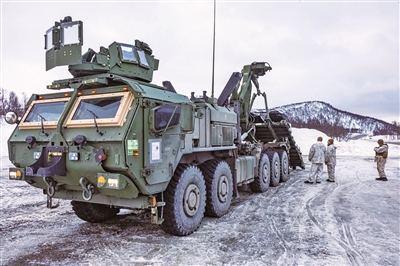
Members of the US Marine Corps participating in NATO's Nordic Response exercise unload snowmobiles on March 7, 2024.
As local conflicts in Europe persist and great power competition intensifies, the US is capitalizing on this opportunity to enhance its strategic ties with Nordic countries, which exacerbates the regional security environment.
Northern Europe moves towards NATO integration
After the outbreak of the Russia-Ukraine conflict, Finland and Sweden began to reconsider their neutral position within the broader context of the confrontation between the West and Russia, and in May 2022, they both applied for NATO membership.
The US was the most supportive and active NATO member during their accession process. In August 2022, the US officially signed a protocol ratifying the entry of the two countries into the organization, and used the refusal to sell F-16 fighters as leverage to pressure Türkiye, which was obstructing Sweden's entry into NATO. Under the leadership of the US, military cooperation between NATO and the two Nordic countries has been significantly strengthened. Over the past two years, multiple multilateral joint military exercises like "Arctic Edge", "Cold Response", and "Arctic Challenge" have been held consecutively.
In April 2023, Finland officially joined NATO. By the end of the same year, the US successively signed defense agreements with Sweden, Finland, and Denmark. The three countries announced that they would open up to 35 military facilities to the US, allowing unrestricted military operations such as personnel deployment, training exercises, and material transfer. Furthermore, the US had also signed similar defense agreements with Norway and Iceland, making it easier for US troops to operate in the Arctic.
The Arctic region strays into camp confrontation
With NATO's ending of northward expansion, the geopolitical map and security landscape in the Arctic and even Europe have been once again reshaped.
The US has successfully introduced multilateral military alliances into Northern Europe. Sweden and Finland, the newly joined countries, are both middle-sized European powers, with the 36th and 50th largest military forces, respectively. Their defense industries are also self-contained. The inclusion of the two countries in NATO not only expands NATO, but also makes it easier for the US to establish a comprehensive alliance network and create an exclusive clique in the Arctic game.
The military security control mechanism in the Arctic has entered a dangerous "window of vulnerability". As the largest Arctic country in terms of geography, Russia possesses numerous military infrastructures in the Arctic region and leads in polar equipment research and development. It is an indispensable party in Arctic governance. With the two Nordic countries, traditionally neutral, "swinging" to NATO, the eight Arctic rim countries have presented a situation in which "NATO's seven countries confront Russia". No country within the Arctic region can mediate any longer, and the risk of conflicts in the Arctic region has significantly increased.
The Arctic power struggle is intensifying
The essential strategic position of the Arctic is reflected in several aspects, including the shortest route for major powers to launch military attacks against each other, intercontinental shipping routes with increasingly extended navigable time due to global warming and melting sea ice, rich natural resources emerging from beneath the icy surface, a tourism industry with great potential, and a significant location for global ecological protection.
The US-led NATO is eager to leverage Northern Europe to gain the first-mover advantage in the Arctic. Encouraged by NATO, Denmark, Norway, Finland, and Sweden have been intensifying their efforts to establish a "joint air force" consisting of 250 fighters since the end of March 2023. For this purpose, they are expected to purchase 143 F-35 fighters from the US, which will become the largest standby deterrent air power under NATO. Among them, the initial batch of F-35 fighters procured by the Finnish Air Force will be deployed to the Rovaniemi Air Base in the Arctic Circle in 2026, serving as NATO's "Arctic Outpost".
The Nordic countries' inclination towards NATO has intensified the regional security dilemma. In light of the growing threat to the northwest of Russia's major cities and densely populated areas, Russian President Vladimir Putin signed an order on February 26 to rebuild the Moscow and Leningrad Military Districts. Russian Defense Minister Sergei Shoigu stated that this adjustment aims to respond to NATO's increasing military capabilities and expansion along the Russian border. It is difficult to predict whether the Nordic countries, which may be pushed by NATO to fight against Russia in the future in a bid to control the Arctic, will remain immune to international changes as they have been before.
The world today is in a new era of turbulence and change. The "securitization" or even "pan-securitization" of the Arctic agenda contradicts the longstanding spirit of Arctic cooperation advocated by the international community and highly respected by Nordic countries. This will intensify security anxiety among all parties and bring negative impacts to the already challenging governance of the global commons.













